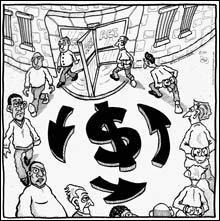Deficits and prison crowding propel the search for a more effective approach
By IAN DONNIS | January 24, 2007
 |
When Rhode island voters narrowly approved a measure last November to allow felons on probation to vote, it marked an important step away from the kind of supposedly “tough on crime” policies that have long typified American criminal justice policy.
Yet even a few years earlier, a bipartisan group of top state officials — including Republican Governor Donald L. Carcieri and Democratic legislative leaders — had sought help from the Coun¬cil of State Govern¬ments in rethinking Rhode Island’s approach to crime and punishment.
And well they should. Over the last 20 years, state spending on corrections in the Ocean State has soared to more than $160 million, up from $30 million in 1985 — and this costs figure prominently in the state’s two-year $350 million state deficit. Meanwhile, the population of the Adult Correctional Institutions in Cranston reached historic highs earlier this month, raising the possibility that some inmates may have to be released before the end of their sentences.
Perhaps the rapidly growing amount of prison-related spending could be justified if the underlying polices were deemed effective. Yet while prosecutors, criminal-defense lawyers and other involved in what has been dubbed the prison-industrial complex have benefited from a non-ending stream of work, the results haven’t been very salutary. Emphasizing incarceration perpetuates a growing prison population — as seen by how a record seven million Americans were in prison, on probation, or on parole by the end of 2005 — although it does little to curb the availability of illegal drugs or to address the underlying causes of crime.
Here in Rhode Island, even with a crime rate lower than that in other states, 31 percent of offenders released from the ACI are back in prison within one year, according to a study by Council of State Governments, and 50 percent are re-incarcerated within three years. The impact, not surprisingly, has been particularly severe in South Providence and other poor parts of the state.
Now, as Carcieri prepares to present his latest budget to the General Assembly, the size of the deficit is focusing attention on whether state officials can craft a criminal justice approach that delivers state savings, fosters public safety, and diminishes growth in the size of the ACI’s bulging population.
There are already glimmers of movement in this direction. The GOP governor, for example, has backed efforts to help offenders effectively make the transition from prison to freedom, and the state is preparing to open a 175-bed reintegration center near the state prison.
Still, even with a change in attitude on the part of many policymakers, moving away from the longstanding emphasis on incarceration — a hallmark of the war on drugs since the presidencies of Ronald Reagan and George H.W. Bush — is a very tall order.
As Representative Steven Costantino (D-Providence), chairman of the House Finance Committee, who worked as a mental health counselor in the ’80s, recalls, “[We as a society] never dealt with the demand [for drugs], and the addiction, and the social problems associated with those issues. It doesn’t surprise me as a result of those policies that you have created an ACI that is filling its cells with people who have addiction or mental health issues.”
 Topics
Topics:
News Features
, U.S. House Committee on Financial Services
, Richard Nixon
, Don Carcieri
, More  , U.S. House Committee on Financial Services
, Richard Nixon
, Don Carcieri
, Prisons
, Criminal Sentencing and Punishment
, Illegal Drugs
, Ronald Reagan
, George Soros
, Neil Corkery
, Mental Health
, Less
, U.S. House Committee on Financial Services
, Richard Nixon
, Don Carcieri
, Prisons
, Criminal Sentencing and Punishment
, Illegal Drugs
, Ronald Reagan
, George Soros
, Neil Corkery
, Mental Health
, Less 